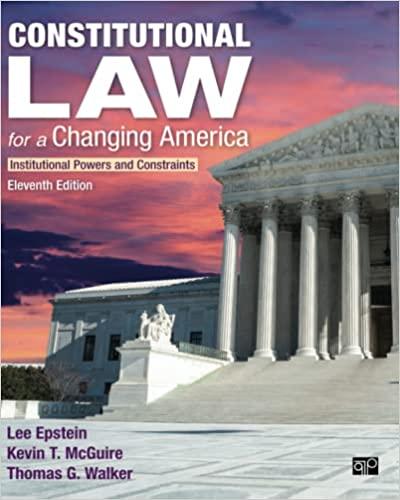Question
Read the case Palace Bar, Inc v. Fearnot and Briefly explain what happened in the case Fact conclusion On January 3, 1974, Garlen Fearnot entered
Read the case Palace Bar, Inc v. Fearnot and Briefly explain what happened in the case
Fact
conclusion
On January 3, 1974, Garlen Fearnot entered the Palace Bar for the purpose of purchasing and being served alcoholic beverages. According to testimony, Fearnot had consumed two shots of whiskey but did not appear intoxicated when, without saying anything, he abruptly left the bar and started toward the rear of the premises. Witnesses stated that Fearnot staggered as he walked, bumped against a booth and stumbled against a pinball machine as he left the front room of the bar and continued toward the rear door, which was the door he customarily used. Subsequently, the staggering Garlen Fearnot, according to conflicting testimony, either fell down the stairs or, while clutching for the handrail, slid to the landing below.
Walters, the bartender and owner-manager of the Palace Bar, watched Fearnot as he left the bar and, thinking something might be amiss because of Fearnot's past history of heart problems, followed him. According to Walter's testimony, he discovered Fearnot on the stair landing and attempted to be of assistance to Fearnot, who was slumped against the rail, by laying him down on the landing. Walters testified that he asked Fearnot if he could help to which Fearnot replied that he would be all right and to just leave him alone. Walters went back to the front of the bar where he discussed the situation with other patrons. Walters and others apparently checked repeatedly on Fearnot's condition although no one called for medical assistance at that time. Thereafter, about an hour later, Walters apparently discovered that Fearnot had lost consciousness whereupon Walters called for the fire department's emergency medical unit, which was located across the alley from the bar. The responding unit was unable to revive Fearnot who was later pronounced dead at the scene by the Greene County Coroner.
The Coroner ruled that upon observing the body it was his opinion that Fearnot died as a result of a natural cause which appeared to him to be a cerebral hemorrhage. He further stated that it was his opinion that the injuries from the fall could not and did not cause Fearnot's death
Dr. James Benz, an Indianapolis pathologist who performed the autopsy, attributed Fearnot's death to heart disease. He also stated that although there were bruises found on the body, these bruises were superficial and that Fearnot did not die as a result of a fall or injury
Evidence further showed that Fearnot experienced a variety of health problems and was, at the time of his death, on total non-service connected disability from the Veteran's Administration. According to testimony, he was known to have had other experiences which required him to lie down for several minutes before being able to continue and he had also confided to others that he had a "bad ticker" or heart problems.
Defendants-Appellants' first assignment of error is based on the contention that Mrs. Fearnot did not prove any proximate relationship between the appellants' acts or omissions and Fearnot's death. We agree with this position and therefore find it unnecessary to consider any of the other issues in this cause. This conclusion also leads us to find the Court of Appeals in error and we therefore vacate their opinion.
It is basic, of course, that the plaintiff had the burden of proving by a preponderance of the evidence that the defendants had a duty to the plaintiff, that the defendant's conduct failed to fulfill or conform to the requisite standard of care required to fulfill that duty and that the plaintiff sustained an injury as a result of that failure. came to the conclusion that the decedent died of natural causes and not from trauma.
In sum, the total evidence is that the decedent died from natural causes and not because of any acts of defendants regardless of whether or not they may have been negligent.
Step by Step Solution
There are 3 Steps involved in it
Step: 1

Get Instant Access to Expert-Tailored Solutions
See step-by-step solutions with expert insights and AI powered tools for academic success
Step: 2

Step: 3

Ace Your Homework with AI
Get the answers you need in no time with our AI-driven, step-by-step assistance
Get Started


